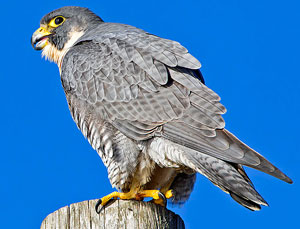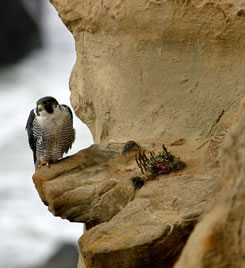Peregrine Falcon
Falco peregrinus
Description & Range:
Peregrin e falcons, historically known as the duck hawk, are widespread birds of prey in the falcon family (Falconidae). They can have a wingspan up to 43 inches in length and can weigh up to 3 ½ pounds with males generally being smaller than females. Adult peregrine falcons have dark blue-gray plumage with light horizontal barring on the chest, a dark head, and thick “sideburns”. In contrast, juveniles are heavily marked with vertical streaking on their breast and are generally brown in color. Overall, color patterns can be variable due to age and geographic locations.
e falcons, historically known as the duck hawk, are widespread birds of prey in the falcon family (Falconidae). They can have a wingspan up to 43 inches in length and can weigh up to 3 ½ pounds with males generally being smaller than females. Adult peregrine falcons have dark blue-gray plumage with light horizontal barring on the chest, a dark head, and thick “sideburns”. In contrast, juveniles are heavily marked with vertical streaking on their breast and are generally brown in color. Overall, color patterns can be variable due to age and geographic locations.
Peregrine falcons are typically found year round in the western United States and northern Mexico. Their winter range includes the Eastern and Southern coastlines of the United States, parts of Central America, and much of South America. The peregrine’s breeding range also includes Alaska and parts of western Canada. Small breeding populations can also be found in areas such as Maryland and Virginia.
Habitat:
The peregrine falcon’s natural breeding habitat consists of open lands with cliffs. However, they have also been found nesting on skyscrapers, bridges, and other tall structures. They can be found nesting along rivers, coastlines, or cities and will build nests at elevations up to 12,000 feet. During migration and winter months, peregrine falcons can be seen in open habitats, often along barrier islands, mudflats, coastlines, lake edges, and mountain chains. Assateague Island is a primary site for migrant peregrine falcons in the fall.
Diet:
Peregrine falcons mostly feed on medium size birds. Four hundred and fifty North American bird species have been documented as prey for the peregrine falcon! Peregrine falcons typically prey upon shorebirds, ducks, grebes, gulls, pigeons, songbirds and (surprisingly) a large amount of bats. In addition, they will occasionally steal prey such as fish and rodents from other raptors. Interestingly enough, like other falcons, their upper bill is notched near the tip to allow falcons to sever the spinal column at the neck of their prey.
Reproduction:
 In early spring, male peregrine falcons select several possible nesting sites. Male peregrines will then court females with a dramatic aerial acrobatic display of dives, loops, and rolls. Males will also present prey to a female in midair while she flies upside down to accept it. After the courtship period, the female will choose the final nest location. The pair will mate for life and will return to the same nesting location year after year.
In early spring, male peregrine falcons select several possible nesting sites. Male peregrines will then court females with a dramatic aerial acrobatic display of dives, loops, and rolls. Males will also present prey to a female in midair while she flies upside down to accept it. After the courtship period, the female will choose the final nest location. The pair will mate for life and will return to the same nesting location year after year.
Historically, peregrine falcons nested on cliff faces and rocky outcrops. However, in Maryland, they typically nest on artificial structures such as bridges, towers, or tall buildings. Peregrines create their nest by scraping out a shallow depression in the sand, dirt, or debris about 9 inches in diameter and 2 inches deep. Both members of a breeding pair may return to the same nesting site in successive years, but do not stay together after nesting.
On average, females lays 3-5 eggs that are a pale rose with brown blotches. Incubation lasts around 33-35 days; both the male and the female will take turns incubating the eggs while the other is hunting food. Peregrines usually lay one clutch of eggs per season. If the first clutch is destroyed, a second clutch may be laid. Chicks generally hatch within 24-48 hrs of one another, are covered with down, and have closed eyes. Within 5 days, the chicks will double in size and are almost fully feathered by 40 days. Both parents provide care for the chicks and will brood them for up to 20 days. Chicks are able to fly when they are 40-45 days old.
Sounds:
Peregrine flacons make an alarm sound of rapid “kek, kek, kek, kek.”
Behavior:
 Peregrine falcons are strong fliers and are reported to be the fastest bird in the world. Their average cruising flight is between 24mph and 33mph increasing to 67 mph when chasing prey. Peregrines hunt by perching or soaring above their prey then dropping down on them at high speeds. Once in their rapid descent on prey (stoop), they can reach speeds of 238mph! The falcon will grab its prey in mid air or strike it hard enough to stun or kill it. They will then catch the falling bird and bite through the neck to kill it. In cities, the peregrine falcon is well adapted for catching pigeons and other medium sized birds. In addition, they will prey on shorebirds and ducks along the coastline.
Peregrine falcons are strong fliers and are reported to be the fastest bird in the world. Their average cruising flight is between 24mph and 33mph increasing to 67 mph when chasing prey. Peregrines hunt by perching or soaring above their prey then dropping down on them at high speeds. Once in their rapid descent on prey (stoop), they can reach speeds of 238mph! The falcon will grab its prey in mid air or strike it hard enough to stun or kill it. They will then catch the falling bird and bite through the neck to kill it. In cities, the peregrine falcon is well adapted for catching pigeons and other medium sized birds. In addition, they will prey on shorebirds and ducks along the coastline.
Conservation
In the early 1960’s, peregrine falcon populations crashed due to the widespread use of DDT and loss of suitable nesting locations. In 1970, the US Fish and Wildlife Service (USFWS) listed the peregrine falcon as endangered.
The ban on use of DDT in 1972 along with reintroduction efforts helped peregrine falcons return to parts of the United States. Reintroduction efforts were a collaboration between the Peregrine Fund at Cornell University, the USFWS, and state wildlife agencies such as the Maryland Department of Natural Resources. Approximately 6,000 captive-reared falcons were reintroduced to parts of the United States. In Maryland, 19 releases occurred between 1975 and 1984. As a result of these reintroduction efforts, in 1983, the first pairs nested in Maryland. One pair nested on the Bay Bridge and the other nested on South Marsh Wildlife Management Area. By 1999, the peregrine falcon was removed from the USFWS List of Endangered and Threatened Wildlife and Plants.
Even today, peregrine falcons are classified as rare in Maryland. Between 2002 and 2006, eighteen confirmed nesting pairs were documented.